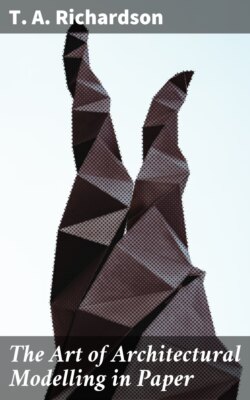Читать книгу The Art of Architectural Modelling in Paper - T. A. Richardson - Страница 5
На сайте Литреса книга снята с продажи.
INTRODUCTION.
ОглавлениеTable of Contents
The art of Architectural Modelling is not so difficult to acquire, as an observer, examining a model and admiring the minuteness of its parts, would be led to suppose. But in order to gain a certain degree of proficiency, a large amount of patience and perseverance is absolutely necessary. The great beauties of a model consist, firstly, in perfect symmetry and correctness of parts, all the angles being clear, well-defined, and sharp, the various minutiæ of detail accurately delineated; and secondly, to the straightness and evenness of the horizontal and perpendicular lines. It will be, therefore, readily understood, that it is these portions of the manipulation which demand the student’s attention, more particularly as the joining of the paper or cardboard by means of a mitre, as well as the cutting of lines on the slant in either a horizontal or curved direction, is somewhat difficult. These difficulties which arise in the student’s path are, however, easily to be overcome, and he must not grow faint-hearted if, after repeated trials, he does not succeed in producing the required effect. Rather at this juncture let him examine some model by an adept in the art, comparing his work with it. By these means he will be enabled to see the points in his own requiring improvement, and then let him continue to labour perseveringly and diligently until he gains a perfect command of his knife and materials, and few will be found but will admit that the result at last obtained fully repays him for his time and labour. There is no doubt that the art is of very great antiquity, and that in former times no building of importance was erected without one having been previously constructed. This not only aided the successful carrying out of the architect’s drawings, but enabled him and his employer to judge better as to the general effect the work would have when completed.
We have mention made of models as early as 1546, when San Gallo (a pupil of Bramante, the original architect of St. Peter’s, at Rome), either himself constructed, or caused to be, a model of his proposed designs for that magnificent structure, in order that the whole might be carried out in the same spirit in the event of his death. On this latter event occurring, the immortal Michael Angelo Buonarotti undertook the important office of architect to St. Peter’s. One of his first tasks was to set aside the model of his predecessor, which had occupied many years in constructing, at a cost of many thousand pounds, while he constructed himself, at a trifling expense and in a few days, another model of his intended work. Numerous other instances of the practical utility of this branch of art might be cited, but the author deems it unnecessary, its importance being at once obvious; and this little work, though devoid of all technicalities, too frequently the fault of works of this description, yet is intended shall be eminently practical. To a large and increasing body, the architectural assistants, it is hoped that this little hand-book will prove to be acceptable; and though written principally for the professional man, it is hoped it may not prove utterly useless or uninteresting to others, who though not members of the architectural profession may yet possess sufficient taste and skill to wish to perpetuate
A DESIGN IN PAPER.
